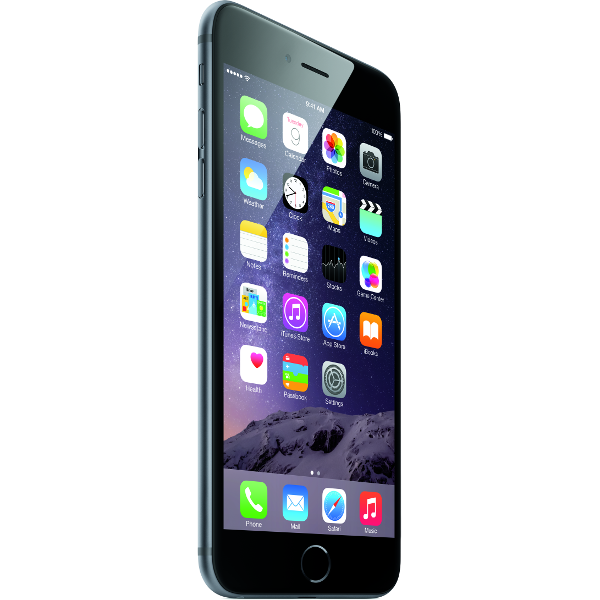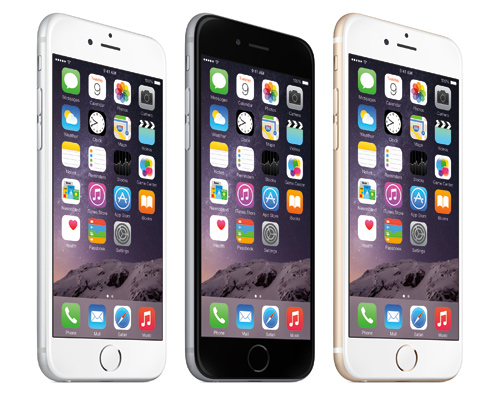Apple iPhone 6 And iPhone 6 Plus Review
The iPhone 6 and 6 Plus are bigger and better than ever, but are they a worthy upgrade for existing iPhone users? What if you previously passed over the iPhone because of its small screen, does it now merit a second look?
Why you can trust Tom's Hardware
Hardware And Availability
Storage And Memory
When it comes to the on-board NAND, Apple giveth and then taketh away. Lacking microSD support, getting sufficient internal storage is crucial, and now bit junkies can binge with the new 128GB option available for both iPhone 6 models. For the less data-hungry, 16 and 64GB options are still available, but oddly missing is a 32GB model. App sizes are growing, and high-resolution photos and videos are adding to the storage pressure. The minimum for today’s flagship devices should be 32GB. I understand the desire to lower the entry point, but that’s what the iPhone 5c and 5s are for now. Apple should have kept the 16GB option alive for these lower-priced models and started the iPhone 6 at 32GB. The good news is that the 64GB iPhone 6 costs the same as the 32GB iPhone 5s did when it launched.
Every piece of hardware in the iPhone 6 sees an incremental improvement except for RAM. I know it’s unrealistic to expect revolutionary changes in design, or radical shifts in technology with each new smartphone model, but is a little extra RAM too much to ask? The iPhone hasn’t seen an increase in memory capacity in two years. That’s right, the iPhone 6 is still stuck at 1GB. I was disappointed last year when the iPhone 5s didn’t receive more RAM, considering the increase in memory pressure from using 64-bit binaries. This year I’m actually angry.
In addition to the 64-bit binaries and larger, more complex apps we have today, the iPhone 6, and especially the 6 Plus, have much higher screen resolutions. This means less RAM available for apps, since a larger chunk of memory is reserved for VRAM. It’s no secret that iOS handles memory management well, but when you have 15 different apps running and 20+ tabs open in Safari, it doesn’t matter how memory efficient iOS is, all of those bits just aren’t going to fit in less than 1GB of RAM. Apple saves a few dollars per phone, degrades the iPhone user experience, and ensures more time wasted switching between apps, reloading webpages and relaunching apps after they run out of memory and crash. If you’re looking for a reason to wait for the iPhone 6s, this would be it.
iPhone 6 And iPhone 6 Plus Tech Specs
The iPhone 6 compares favorably to other smartphones in its class. The upgrades to the CPU and GPU inside the A8 SoC should ensure competitive, if not best-in-class, performance. The iPhone’s camera, while lacking in pixel count, always manages to produce good results, and it catches up to the competition with the inclusion of 802.11ac Wi-Fi, NFC and LTE Category 4. Battery life over the iPhone 5s should also improve with the larger power source.
The screen resolution for the iPhone 6 is adequate, but fails to really stand out from the crowd. RAM capacity is the other notable deficiency. Did I mention that already?
The iPhone 6 and 6 Plus are nearly identical with size being the obvious differentiator. The iPhone 6 Plus is about 15% taller and wider than the iPhone 6, in addition to being 0.2mm thicker; the extra volume makes the 6 Plus 33% heavier. With the bigger size comes a bigger screen, supporting a full 1080p resolution and a higher pixel density than the iPhone 6. Sitting behind the 6 Plus’ larger screen is an equally large battery, packing enough power to outlast the smaller iPhone 6. The final difference between the two new iPhones, and the only one not related to size, is the inclusion of optical image stabilization (OIS) for the rear camera on the 6 Plus.
Based on the similar internal hardware, the two iPhones should have equivalent CPU, memory, camera and wireless performance. The only significant performance difference between the two models should be on-screen GPU rendering, since the iPhone 6 has fewer pixels to draw.
Get Tom's Hardware's best news and in-depth reviews, straight to your inbox.
The A8 SoC in the iPhone 6 Plus should give it the edge over its large-screened competitors in CPU performance. It will be interesting to see how the PowerVR GX6450 in the A8 compares to the Adreno 420 used in Snapdragon 805 when rendering at higher resolutions.
While the 6 Plus doesn’t support removable storage, it does at least offer 128GB of internal NAND, the most of any smartphone.
Curiously, the 6 Plus is both taller and wider than the other 5.5-inch devices. It’s even taller than the 5.7-inch Galaxy Note 4. The circular Touch ID sensor is partially to blame, since it requires a fair amount of space below the screen. Being thinner than the competition can’t make up for its large frontal area, making the 6 Plus one of the heavier phab…..large phones.
Availability And Options
The iPhone 6 and 6 Plus support up to 20 LTE bands, seven more than the iPhone 5s, and is available for numerous carriers around the world. Apple provides this helpful chart detailing iPhone’s LTE capabilities.
Qualcomm's MDM9625M Gobi modem and WTR1625L RF transceiver provide access to this plethora of frequency bands. The iPhone 6 also includes Qualcomm's envelope tracker IC, which improves battery life, but not the other two components of Qualcomm’s RF360 front-end package: the antenna matching tuner and CMOS power amplifier and antenna switch. Instead, it uses an antenna switch from RF Micro Devices.
Both of the new iPhones offer 16, 64 and 128GB storage options, and come in the same three colors as the iPhone 5s: gold, silver and space gray.
| iPhone 6 | iPhone 6 Plus | ||||||
|---|---|---|---|---|---|---|---|
| With Contract | Unlocked | With Contract | Unlocked | ||||
| 16GB | $199 | 16GB | $649 | 16GB | $299 | 16GB | $749 |
| 64GB | $299 | 64GB | $749 | 64GB | $399 | 64GB | $849 |
| 128GB | $399 | 128GB | $849 | 128GB | $499 | 128GB | $949 |
After discussing the iPhone’s new features and incremental improvements, lets dive a little deeper into its design, function and performance.
Current page: Hardware And Availability
Prev Page Why The iPhone 6 Is A Big Deal Next Page iPhone 6 Look And Feel-
blackmagnum Everyone would want to own one and be the envy of their peers. They want a device that is attractive, well-made and intuitive. That's how Apple sells them by the millions, don't you agree?Reply -
lanbaner Nvidia has a better GPU. The G3 has a better display. The Note 4 has better camera. Gone are the days were the iPhone was the leader on all fronts. Would be nice to see all the strengths from the competition in one phone. Considering the transition to 20nm for Maxwell early next year we could possibly see an iPhonekiller on all aspects. Although I have to agree that the build quality on the iPhones is always top notch.Reply -
M3God Other then just sticking to just 1GB internal memory, there is no mention that apple switched to cheaper and slower TLC memory to make more profits while screwing the customer. The TLC memory has been linked to crashes and bootloops that require a trip to the apple store.Reply -
aaaas I browse the Web and talk on the phone on Verizon all the time. At least the last two generations of devices have been able to do this... at least for android...Reply
Interesting article, as I've been considering a switch to iphone. -
KaptainK " Wi-Fi calling is currently only supported by T-Mobile in the U.S."Reply
Not True! Republic Wireless has been using wi-fi calling for years. Republic also includes a feature where it will hand the call off from wi-fi to cellular if you leave the wi-fi zone during the call. Does the iPhone do this?? -
cknobman A. Thanks for including the Lumia 1520 in the comparison chart of phablets, most other sites dont do this.Reply
B. The price for the 6 plus in that same chart ($299) is on contract while every other device price is off contract.
As a whole if you are an iPhone user I am sure you are happy with the changes made to the 6. Outside of that the iPhone "cool factor" ship has sailed and this wont be winning over many Android users. -
cmi86 How can this guy sit here and hump apples leg by saying the A8 should be competitive if not class leading when it's competition averages over 1Ghz higher clock speed and 2 more cores.... I know a lot of people doing reviews now a days feel obligated to shine up certain companies and make their products appear in a positive light. This is not that... this is a blatant lie.Reply -
SirKnobsworth How can this guy sit here and hump apples leg by saying the A8 should be competitive if not class leading when it's competition averages over 1Ghz higher clock speed and 2 more cores.... I know a lot of people doing reviews now a days feel obligated to shine up certain companies and make their products appear in a positive light. This is not that... this is a blatant lie.Reply
Clock speeds and core counts can be deceptive, the key point here being that Apple's Cyclone cores can execute about twice as many instructions per clock cycle as most of their competitors. This shows up in the benchmarks - the iPhone 6 and 6+ do very well in single threaded tests, though tend to lag behind competitors in multithreaded tests like physics. Note that this is also the approach that Nvidia is taking with their Denver cores - fewer, bigger cores as opposed to more small cores.
How this translates into actual performance will vary of course - most smartphone workflows aren't particularly well threaded so having four cores as opposed to two probably won't make a huge difference in many situations, but I'm sure there are plenty of exceptions. -
ZXS ReplyDue to their zero reading on the black level tests, AMOLED displays are said to have an infinite contrast ratio.
MATT, do you know this is Samsung's marketing BS?
Smartphone displays reflect about 6% of incoming light (which is much more than LCD backlight emits). Actual contrast of AMOLED is worse than that of LCD since the reflections are so high, but maximum brightness is much lower than that of LCD.


